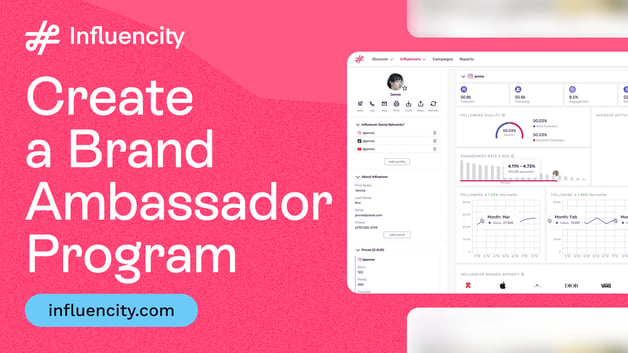Successful Influencer Payment Strategies That Drive Results
Having a strong influencer payment strategy is key to ensuring fair compensation and spending your marketing budget effectively. Choosing the right payment strategy will attract top talent and foster stronger, more productive influencer relationships.
In this article, we'll explore various influencer payment strategies that can drive results and maximize the return on your investment (ROI) and you’ll learn:
- The importance of aligning influencer compensation with your campaign goals.
- How to identify the best payment strategy for different types of influencer collaborations.
- Tips for fostering transparency and respect in influencer partnerships.
- How Influencity can streamline your influencer payment processes and help you manage global payments efficiently.
Understanding how to craft a tailored influencer payment strategy is key to leveraging influencer marketing effectively.
What is an Influencer Payment Strategy?
An influencer payment strategy is a structured approach to compensating social media content creators who promote products and services. This strategy is pivotal in influencer marketing, as it directly influences the motivation and performance of influencers. Adopting a transparent and fair payment framework helps businesses build stronger, more productive relationships with influencers, which can significantly enhance campaign outcomes and brand visibility.
In the context of influencer marketing, payment strategies are not one-size-fits-all. Instead, they should be tailored to the specific goals of a campaign and the unique attributes of each influencer. From determining the right mix of payment types to understanding the various forms of collaborations with influencers, companies must consider multiple factors to craft an effective strategy.
For instance, a performance-based payment model might be suitable for campaigns aiming to drive sales, while product seeding could work better for brand awareness efforts. Each approach offers different incentives and benefits, and choosing the right one depends on what you want to achieve and the nature of the influencer partnership.
Ultimately, the effectiveness of an influencer payment strategy hinges on its ability to align the interests of both the brand and the influencer. Well-planned payment strategies ensure fairness and transparency, but they also foster long-term collaborations that benefit both parties.
Choosing the right payment model allows you to motivate influencers to create top-notch, captivating content that connects with your audience. This approach can significantly expand your campaign's reach and boost the overall effectiveness of your marketing efforts.
Types of Influencer Payment Strategies
The first step in navigating influencer payments is to familiarize yourself with the various payment models available and determine which one best suits your campaign goals. From flat fees to performance-based models, each strategy offers unique advantages and challenges.
Let’s explore these strategies to find the best fit for your brand.
Flat Fee Payments
Flat fee arrangements are straightforward: influencers receive a predetermined amount for their services irrespective of the performance of their posts. This method is often preferred when brands require a predictable budget for their influencer marketing campaigns. It’s particularly effective for product launches or brand awareness drives, where specific deliverables are agreed upon in advance.
Product Seeding
Product seeding is where you send free products to influencers in exchange for their review or promotion. While not a direct cash payment, this form of influencer gifting can be a cost-effective way to generate organic content and buzz around a product. It’s crucial, however, that brands make clear agreements with influencers about the expectations and possible coverage to avoid misunderstandings.
Pay-Per-Post or Cost-Per-Action
In a pay-per-post model, influencers are paid for each post they make on behalf of the brand. Alternatively, cost-per-action (CPA) arrangements compensate influencers based on the actions taken by their audience, such as clicks, sign-ups or sales. These models are suitable for campaigns aiming to drive specific consumer actions, offering a measurable ROI that can be directly attributed to hired influencers.
Performance-Based Payments
Performance-based payments are becoming an increasingly popular influencer recruitment strategy. These agreements align the interests of the brand and the influencer by basing compensation on the achievement of specific performance metrics, such as engagement rates or conversion numbers. This strategy can motivate influencers to create more compelling content.
Long-Term Partnerships
Finally, establishing long-term partnerships with influencers can lead to more authentic and impactful promotions. When influencers are engaged over an extended period, they develop a deeper understanding of the brand and its products, which can result in more genuine endorsements. These arrangements often involve a mix of payment strategies, including regular fees, bonuses for performance and product gifting.
Tips for Compensating Influencers Fairly
We are now going to take a look at a few essential tips and best practices to help you compensate fairly, whatever payment model you choose, and foster transparency, respect, and mutual benefit in your influencer partnerships.

- Transparency and communication: Clear, open lines of communication are the backbone of any successful influencer relationship. From the outset, it's crucial to be transparent about what the payment covers, such as the number of posts, specific deliverables, and any expectations in terms of performance metrics. This clarity prevents misunderstandings and helps you build a foundation of trust, encouraging influencers to be more engaged and enthusiastic about your campaign.
- Understand the influencer's value: Assessing an influencer’s value is vital for fair compensation. Consider factors such as the influencer's reach, engagement rate, audience demographics, and the quality and uniqueness of their content. Understanding all this information helps you offer competitive payments that reflect the actual value the influencer brings to your brand.
- Flexibility in payment structures: Being flexible with your payment structures can greatly enhance an influencer's motivation levels. For example, incorporating performance bonuses for exceeding KPIs or offering higher rates for long-term commitments can encourage influencers to give it their all.
- Regular reviews and adjustments: Finally, regularly reviewing and adjusting each influencer’s payment terms in line with ongoing performance and market standards can help you maintain a fair rate of compensation that sustains the motivation and commitment of each collaborator.
How Influencity Can Help
Influencity simplifies the complex task of managing influencer payments, making it easier for brands to handle transactions with influencers from all around the world.
Here’s how Influencity’s platform streamlines this process:
- Global payments. Influencity allows you to send money to influencers in over 186 countries and 143 different currencies. This means you can work with almost any influencer around the world without worrying about how to pay them.
- Keep track of payments. The platform has a dashboard where you can see all the payments you need to make. You can check who has been paid, how much, and for what campaign. This helps you stay organized so that everyone gets paid on time.
- Simple to use. Adding influencers to your payment list is straightforward. You can add them one by one or in groups if they are part of the same campaign. Once you have added everyone, simply enter all the payment details, and you're set to go. The platform handles the rest, from making sure payments are sent to dealing with taxes and fees.
- Save time on paperwork. Influencity also helps reduce the time you spend on paperwork by combining all your payments into one invoice. This makes your accounting simpler and faster, which is a big help if you're managing lots of influencers or large campaigns.
Ultimately, Influencity streamlines the entire influencer payments process, making it easier for you to manage your campaigns and nurture positive relationships with influencers who can boost your brand's engagement and ROI.
Tags:























%20and%20How%20Can%20They%20Benefit%20Your%20Brand%20article.jpg?length=628&name=What%20Are%20Key%20Opinion%20Leaders%20(KOL)%20and%20How%20Can%20They%20Benefit%20Your%20Brand%20article.jpg)








